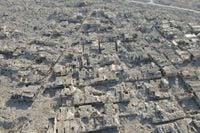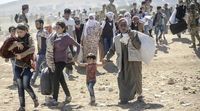Nearly a year after the dramatic fall of Bashar al-Assad’s regime, Syria stands at a crossroads—caught between the promise of massive reconstruction and the peril of deepening political and sectarian divides. The new Sunni Muslim government, headed by President Ahmed al-Sharaa, is facing perhaps the greatest challenge in the country’s modern history: how to rebuild a nation shattered by thirteen years of civil war, with costs now estimated to range from $216 billion to as much as $900 billion, according to various reports from the World Bank and statements by al-Sharaa himself.
President al-Sharaa made his ambitions clear in a historic speech at the United Nations General Assembly on September 24, 2025—the first time a Syrian leader has addressed the assembly since 1967. He declared that Syria’s reconstruction would “turn a page on a wretched past” and reintegrate the country into the international community. This message of moderation and renewal has been echoed in a coordinated campaign by his government to attract foreign investment, secure the removal of Western sanctions, and project an image of stability and reform. But beneath the surface, the reality is far more complicated.
The scale of Syria’s destruction is staggering. According to the World Bank, the country’s real gross domestic product (GDP) fell by nearly 53 percent from 2010 to 2022, and infrastructure alone accounts for nearly half of the total damage. The Aleppo region, Damascus, and Homs province are among the hardest hit, with entire neighborhoods reduced to rubble and millions of Syrians displaced or living in dire poverty. As Jean-Christophe Carret, Director of the World Bank’s Middle East Department, put it, “The upcoming challenges are enormous, but the WB is ready to work with the Syrian people and the international community to support recovery and reconstruction.”
To finance this Herculean task, Syria is almost entirely dependent on foreign capital. The government has signed investment agreements with regional heavyweights Saudi Arabia, Qatar, and Turkey—each with their own interests and visions for the country’s future. Qatar, a backer of Islamist movements, has pledged more than $7 billion for energy and infrastructure projects, aiming to shape the new Syria in its image. Saudi Arabia, wary of both Iranian and Qatari influence, has committed $6.4 billion, seeking to stabilize the country while curbing the spread of political Islam and the regional Captagon drug trade. Turkey, leveraging its proximity and industrial might, is pushing for $10 billion in bilateral trade and has become a dominant player in reconstruction, securing deals for electricity generation and the redevelopment of Damascus International Airport.
President al-Sharaa has proven adept at navigating these competing interests, extracting maximum financial benefit while trying to preserve a measure of Syrian sovereignty. On September 4, 2025, he launched the Syrian Development Fund, designed to channel donations and international grants into rebuilding vital sectors like energy, water, health, and education. The fund quickly garnered over $82 million in donations and was touted by Syrian officials as a model of transparency, with promises of public disclosure for all expenditures. Yet critics have raised alarms about the fund’s direct link to the presidency and the absence of independent oversight, warning of potential corruption and a lack of accountability.
At the same time, the government’s outward moderation masks troubling developments at home. While al-Sharaa has avoided extremist rhetoric in international forums, his regime has relied heavily on Sunni jihadist militias, many supported by Turkey, to consolidate power. In March and July 2025, his forces carried out massacres against the Alawite and Druze minorities, respectively—events that have raised fears of renewed sectarian violence. A video circulated in October 2025 shows schoolchildren in Damascus participating in morning assemblies where teachers lead them in religious and ideological chants, signaling the emergence of systematic jihadist education in the new Syrian state.
Politically, the new transitional constitution signed in March 2025 concentrates significant powers in the presidency, raising concerns about transparency and checks and balances. Parliamentary elections scheduled for October 2025 were designed so that one-third of the seats would be appointed directly by al-Sharaa, with the rest filled through an indirect process involving pre-selected committees. Crucially, elections in the Druze-majority Suwayda province and the Kurdish areas of Hasakah and Raqqa have been indefinitely postponed, ostensibly due to security concerns. This exclusion of key minorities, alongside the violence perpetrated against them, has cast a long shadow over al-Sharaa’s promises of a “New Syria.”
Despite these realities, the international community has shown a willingness to engage. The Trump administration lifted some U.S. sanctions on Syria on June 30, 2025, in a move that was partially rolled back pending congressional action. Foreign Minister Asaad Shaibani’s visit to Washington in September 2025 further signaled a thaw in relations, with talks focused on sanctions relief and political normalization. Meanwhile, Mastercard returned to Syria after a 14-year absence, signing a memorandum of understanding with the Central Bank to develop a national digital payments system—a powerful sign that Western financial institutions may be ready to re-enter the Syrian market.
The World Bank has provided an initial $146 million for Syria’s electricity grid, and the European Union has pledged nearly €2.5 billion for 2025-2026. These moves, coupled with the return of international investors, suggest that economic stabilization is now the primary goal of the new regime. As Syria’s Finance Minister Mohamed Barnieh put it, “Today, more than ever, it is imperative that the international community mobilizes its support and partnerships to help Syria.”
Yet as the Gulf states and Turkey vie for influence, the old patrons of Syria—Iran and Russia—have seen their fortunes wane. Iran, which invested $20-30 billion supporting Assad and used Syria as a corridor to Hezbollah in Lebanon, has suffered a catastrophic loss. Russia, while maintaining its strategic bases at Tartus and Khmeimim, has seen its economic clout diminish: the new government terminated the Russian company Stroytransgaz’s contract to manage the port of Tartus, handing it to the UAE’s DP World. In a symbolic gesture, al-Sharaa visited Moscow on October 15, 2025, seeking to reset relations and even requesting the extradition of Bashar al-Assad, now in exile in Russia.
The security situation remains volatile. Although Hezbollah’s influence has been weakened, it continues to use Syrian territory to plan attacks and smuggle weapons, according to research by the Alma Center. Meanwhile, the risk of renewed internal conflict looms large, as the regime’s exclusion of minorities and reliance on Islamist factions threaten to reignite the grievances that fueled the civil war in the first place.
As Syria embarks on its reconstruction, the stakes could hardly be higher. The influx of foreign capital may help rebuild shattered cities and infrastructure, but the unresolved political and sectarian tensions—paired with an autocratic, exclusionary regime—could undermine these efforts and set the stage for new cycles of instability. The world is watching closely, but for millions of Syrians, the question remains: will the promise of a “New Syria” finally deliver peace and prosperity, or will it simply usher in another era of uncertainty?

